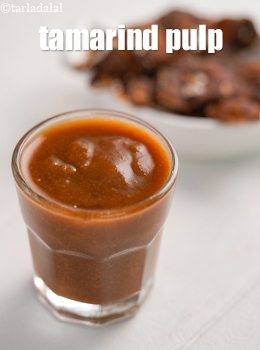
Also Known as
Tamarind extract, Imli ka guda
What is tamarind pulp, imli pulp?
Tamarind pulp is a thick extract made from tamarind. To make tamarind pulp at home, soak the tamarind pods in just enough warm water for about 15-20 minutes or till they turn soft. Mash using your hands and roughly strain the pulp (you can do it with your hands itself) to discard the hard black coloured seeds as well as the fibrous parts. The soft pulp you have strained out is tamarind pulp. This thick, smooth, brown coloured mixture cam be used to impart a sour flavour to many dishes.
How to Select tamarind pulp
• Select fresh soft tamarind to make tamarind pulp at home.
• You can also buy readymade pulp available in market. Ensure to check the manufacturing and expiry dates along with the seal of the packet.
• If buying readymade pulp, you might also want to check the ingredients as most brands add salt, vinegar or other preservatives.
Culinary Uses of tamarind pulp
• Having tamarind pulp handy can help quickly prepare tasty Indian dishes like chutneys, curries, dals and many south Indian delicacies like sambhar and rasam.
•
Indian Sabzi’s using tamarind pulp
A slight sour taste in sabzi is always a superb taste which comes from tamarind pulp. Few recipes listed below which will give you a tangy taste in every bite you take.
1. Bharleli Vaangi an all-time favourite Maharashtrian sabzi that tastes great with both rice as well as rotis.
2. Maharashtrian Patal Bhaji made with colocassia leaves and chana dal, perked up with a special coconut-based masala.
3. Mixed Kathol features a wonderful combo of pulses cooked and presented the Guajarati way.
4. Panchamrut spicy Maharashtrian version, which is part of the traditional puja thali, and also served as an accompaniment in a traditional.
5. Chawli Bean Subzi sure to please your palate with its exciting sweet, sour and spicy flavour.
South Indian recipes using tamarind
South Indians use lot of tamarind in their daily cooking routine, it’s a must in their food, below are the recipes where tamarind pulp is beautifully used , to give you the balanced taste.
1. Kerala Sambar flavour of coriander seeds is a bit stronger than that of other spices, and this makes the sambhar very aromatic and flavourful.
2. Pongal Kootu a tongue-tickling mixed vegetable curry made during Makar Sankranti or Pongal in South India.
3. Tamarind Rice well-known all over South India, although there are likely to be mild variations in the way it is performed in various regions.
The pulp can also be used to impart tartness to certain pickles, especially those made with bland ingredients like greens or bitter ingredients like bitter gourd.
• Tamarind pulp can also be diluted with warm water to acquire tamarind water, used to prepare appetising drinks.
• It is an important ingredient in Worcestershire sauce.
• Tamarind pulp combined with jaggery and cumin seeds results in a tasty chutney that goes well with snacks like samosas and pakodas.
• Tamarind pulp can be combined with roasted urad dal and coconut or sautéed veggies like ridge gourd, and tempered with mustard and asafoetida, to make tasty south Indian style chutney. This chutney, often called thogayal, can be relished mixed with steaming hot rice and ghee or til oil. It can also be served along with idlis and dosas.
• Tamarind pulp is also used in the preparation of many Thai dishes.
How to Store
• If refrigerated in an airtight, non-reactive container, preferably glass, tamarind pulp can last for one or two weeks.
• To preserve the pulp for a longer time, store in an airtight container in the deep freezer. Thaw and use as required.
Health Benefits of tamarind pulp
• Tamarind is a rich source of vitamins, fibre, potassium, magnesium and other nutrients necessary for good health.
• Tamarind is a good source of antioxidants that fight against cancer and also contains carotenes, vitamin C, flavonoids and B-vitamins.
• It is also rich in thiamin (36% of daily required levels), vitamin A, folic acid, riboflavin and niacin.
• Much of these vitamins plays antioxidant as well as co-factor functions for enzyme metabolism inside the body.
• It is beneficial for treating fevers and common cold.
• Gargling tamarind water is helpful in sore throat.
• Tamarind is used to treat bile disorders.
• Tamarind lowers cholesterol and promotes a healthy heart.
• This spice condiment is also used as an emulsifying agent in syrups, decoctions, etc., in different pharmaceutical products.
• Tamarind pulp is a useful remedy for vomiting, flatulence, constipation and indigestion.
• Tamarind pulp can also help improve appetite.